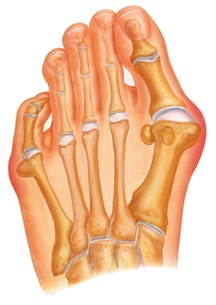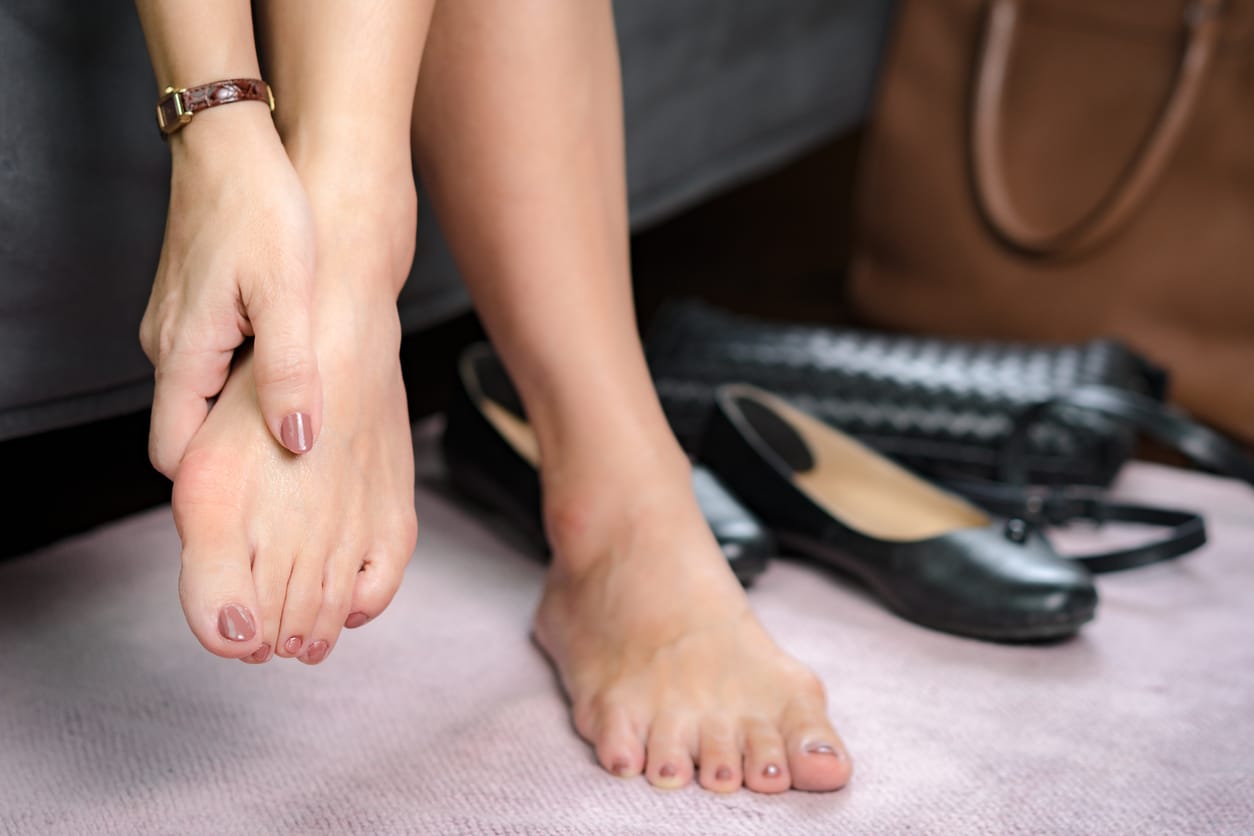What Is a Bunion?
A bunion is an enlargement of the joint at the base of the big toe—the metatarsophalangeal (MTP) joint—that forms when the bone or tissue at the big toe joint moves out of place. This forces the toe to bend toward the others, causing an often painful lump of bone on the foot. Since this joint carries a lot of the body’s weight while walking, bunions can cause extreme pain if left untreated. The MTP joint itself may become stiff and sore, making even the wearing of shoes difficult or impossible. A bunion–from the Latin "bunio," meaning enlargement–can also occur on the outside of the foot along the little toe, where it is called a "bunionette" or "tailor’s bunion."
Symptoms

- Development of a firm bump on the outside edge of the foot, at the base of the big toe.
- Redness, swelling, or pain at or near the MTP joint.
- Corns or other irritations caused by the overlap of the first and second toes.
- Restricted or painful motion of the big toe.
How Do You Get a Bunion?
Bunions form when the normal balance of forces that is exerted on the joints and tendons of the foot becomes disrupted. This can lead to instability in the joint and cause the deformity. They are brought about by years of abnormal motion and pressure over the MTP joint. They are, therefore, a symptom of faulty foot development and are usually caused by the way we walk, and our inherited foot type, our shoes, or other sources.
Although bunions tend to run in families, it is the foot type that is passed down—not the bunion. Parents who suffer from poor foot mechanics can pass their problematic foot type on to their children, who in turn are prone to developing bunions. The abnormal functioning caused by this faulty foot development can lead to pressure being exerted on and within the foot, often resulting in bone and joint deformities such as bunions and hammertoes.
Other causes of bunions are foot injuries, neuromuscular disorders, or congenital deformities. People who suffer from flat feet or low arches are also prone to developing these problems, as are arthritic patients and those with inflammatory joint disease. Occupations that place undue stress on the feet are also a factor; ballet dancers, for instance, often develop the condition.
Wearing shoes that are too tight or cause the toes to be squeezed together is also a common factor, one that explains the high prevalence of the disorder among women.
Can Bunions go away on their own or will surgery be required?
Once a bunion has formed, your toe won’t return to its normal position without surgery. Bunions cannot correct themselves after they have formed. That doesn’t mean you will absolutely need to have surgery, however. Whether or not you need surgery will be a factor of the frequency and level of the pain your bunion is causing, or if it is impeding your daily activities.
How you can alleviate your Bunion pain:
- Apply a commercial, nonmedicated bunion pad around the bony prominence.
- Wear shoes with a wide and deep toe box.
- If your bunion becomes inflamed and painful, apply ice packs several times a day to reduce swelling.
- Avoid high-heeled shoes over two inches tall.
- See your podiatric physician if pain persists.
Conservative Treatment For Bunion Pain
Treatment options vary with the type and severity of each bunion, although identifying the deformity early in its development is important in avoiding surgery. Podiatric medical attention should be sought at the first indication of pain or discomfort because, left untreated, bunions tend to get larger and more painful, making nonsurgical treatment less of an option.
The primary goal of most early treatment options is to relieve pressure on the bunion and halt the progression of the joint deformity. A podiatric physician may recommend these treatments

Padding & Taping
Often the first step in a treatment plan, padding the bunion minimizes pain and allows the patient to continue a normal, active life. Taping helps keep the foot in a normal position, thus reducing stress and pain.
Medication
Anti-inflammatory drugs and cortisone injections are often prescribed to ease the acute pain and inflammations caused by joint deformities.
Physical Therapy
Often used to provide relief of the inflammation and from bunion pain. Ultrasound therapy is a popular technique for treating bunions and their associated soft tissue involvement.
Orthotics
Shoe inserts may be useful in controlling foot function and may reduce symptoms and prevent worsening of the deformity.
Bunion Surgical Treatment Options
When early treatments fail or the bunion progresses past the threshold for such options, podiatric surgery may become necessary to relieve pressure and repair the toe joint. Several surgical procedures are available to the podiatric physician. The surgery will remove the bony enlargement, restore the normal alignment of the toe joint, and relieve pain.
A simple bunionectomy, in which only the bony prominence is removed, may be used for the less severe deformity. Severe bunions may require a more involved procedure, which includes cutting the bone and realigning the joint.
Recuperation takes time, and swelling and some discomfort are common for several weeks following surgery. Pain, however, is easily managed with medications prescribed by your podiatric physician.
Is recovery involved in all bunion treatments?
As mentioned above, the only true treatment or solution for a fully formed bunion is surgery, and this will involve recovery.
Other treatment options, such as padding or taping, orthotics, or even physical therapy, all may enable you to live with your bunion. The goal in these conservative treatment options is to control your pain and try to keep your foot in a normal position. None of these conservative treatment options involve any recovery.
How to prepare for Bunionectomy surgery
Preparation depends upon how extensive your bunion is, as this will dictate the surgical method we need to use to address it. For a simple bunionectomy, we may have you in a bunion shoe and you’ll be able to walk immediately. That won’t create wholesale changes in your lifestyle. But if we need to cut the bone and place screws, you’ll need to keep all weight off that foot. This will obviously create inconvenience in some areas of your life.
When your Foot & Ankle Clinics of Utah doctor is discussing our options prior to your surgery, you’ll know what to expect and you can prepare accordingly.
As with any surgery, you’ll need to stop taking blood thinners, aspirin, anti-inflammatory medications, and most herbal supplements a few days prior to your procedure, as these can cause increased bleeding.
How painful is recovery after a bunionectomy?
After your surgery before we apply your dressing, your Foot & Ankle Clinic surgeon will numb your foot with a long-acting anesthetic that should get you through the first night. After that, you’ll need to manage the pain with prescription pain medication. You’ll have the most pain during the first three days after your surgery. But there will be some moderate pain involved in your recovery.

How long it can take to fully heal after a Bunionectomy
If your surgery involved cutting or removing bone, which most do, then it will take about 6 weeks for the bone to mend. This cannot be rushed or accelerated. Following that, you will have rehabilitation. The timeframe for full recovery, where you can get back to running or other impact exercise, may take up to six months.
What results can I expect after my bunion surgery?
Research has shown that over 85 percent of those who have had bunion surgery are satisfied with the outcome of their surgery. Most of the other 15 percent have strong improvement, but still have some pain and limitations.
But if you’re in daily pain just walking around the house, bunion surgery with our four Foot & Ankle Clinics of Utah podiatric surgeons could be one of the best things you’ve ever elected to do.
Can my bunion return after having bunion surgery?
Recurrence of a bunion can happen. Statistics show that as many as 16 percent of people having a bunionectomy have a new bunion develop in future years. This doesn’t have to happen, but it will take some changes. First off, it’s important to remember that the bunionectomy performed by your surgeon targeted your existing bunion. That doesn’t mean physics and other forces can’t create another bunion in the future.
The reason most bunions return is the same reason they form in the first place — there is abnormal movement of a set of joints found just below your ankle. The structure of your foot that created your first bunion can cause a recurrence. This isn’t a failed surgery; it’s simply your anatomy.
But this isn’t a foregone conclusion. That would make bunion surgery a waste of time. We will work with you to make the changes necessary to ensure your bunionectomy removes your bunion and your pain for the long haul.
How you can prevent a Bunion from returning
The first step is to follow your Foot & Ankle Clinics of Utah podiatric surgeon’s instructions for your physical rehabilitation after your bunionectomy. This will likely involve both physical therapy and exercises and stretches you will perform on your own.
We will often recommend our patients wear a removable splint at night. These soft splints work to prevent shifting of your realigned toe.
We’ll likely want to get you into a pair of custom orthotics for your shoes. These are designed to keep your foot joints in alignment, providing the stability to the big toe joint necessary to stop the formation of a bunion.
We’ll also recommend some lifestyle changes. Certain forms of footwear are more likely to encourage the development of a bunion. High heels are the main culprit, although any shoes with an overly small toe box are problematic. If you must wear high heels, it’s wise to do so less frequently.
Bunion Tips
- Wear comfortable shoes that conform to the shape of your foot.
- Wear shoes with a wide and deep toe box.
- Always fit the larger foot and have your feet sized each time you purchase shoes.
- Apply a commercial, nonmedicated bunion pad around the bony prominence.
- If your bunion becomes inflamed and painful, apply ice packs several times a day to reduce swelling.
Avoid high-heeled shoes over two inches tall. - Seek professional podiatric evaluation and assistance with uncomfortable or noticeable bunions.
The Doctors at the Foot & Ankle Clinics of Utah have been trained specifically and extensively in the diagnosis and treatment of all manner of foot conditions. This training encompasses all of the intricately related systems and structures of the foot and lower leg including neurological, circulatory, skin, and the musculoskeletal system, which includes bones, joints, ligaments, tendons, muscles, and nerves.

If you are experiencing Bunion pain, do not hesitate to contact our top doctors to learn about the treatment options that may be available to you! Fill out the form in our contact form or give us a call. Our practice has offices located in American Fork, Payson, Springville, and Orem, UT.